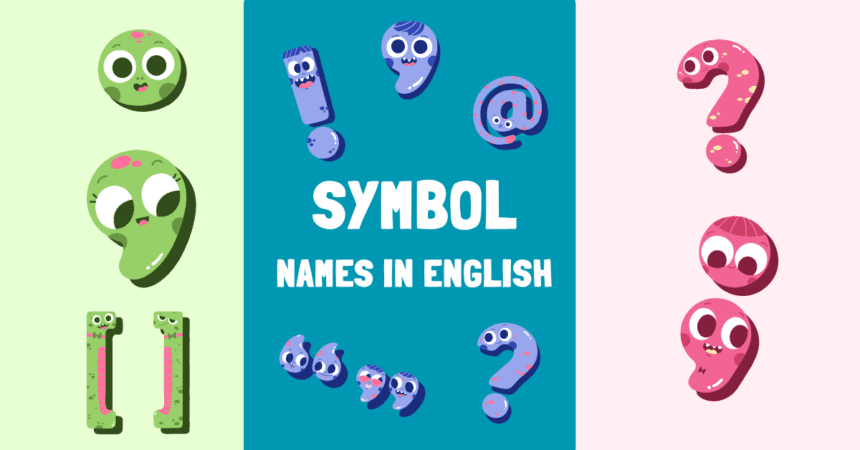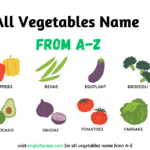We have included the more than 300 most common symbols and updated the list of Symbol names in English.
The English language utilizes a wide range of symbols and punctuation marks to convey meaning, enhance communication, and facilitate clear expression. These symbols, also known as typographical symbols, serve various purposes, such as indicating emphasis, denoting mathematical operations, or separating different elements within a text. Understanding the names and functions of these symbols can greatly enhance one’s ability to communicate effectively in written form.
In this list, we will explore commonly used typographical symbols and punctuation marks, their names, and the roles they play in written communication. Whether you are a student or a professional, this list will serve as a valuable resource to expand your knowledge and make your written expressions more precise and impactful.
10 Common Types of Symbols
There are numerous symbols in English, including letters of the alphabet, punctuation marks, mathematical symbols, and various other symbols used for different purposes. Here’s a comprehensive list of symbols along with their names:
Table of Contents
Letters of the Alphabet:
A, B, C, D, E, F, G, H, I, J, K, L, M, N, O, P, Q, R, S, T, U, V, W, X, Y, Z
Punctuation Marks:
Punctuation marks are symbols used in writing to separate sentences and their elements and to clarify meaning. Here is a list of common punctuation marks and their uses:

1. End Marks
- . (Period): Indicates the end of a declarative sentence or statement.
- ? (Question Mark): Indicates the end of a direct question.
- ! (Exclamation Mark): Indicates strong emotion or emphasis.
2. Pausing and Separating
- , (Comma): Used to separate items in a list, to set off introductory elements, to separate clauses, and to indicate a pause in a sentence.
- ; (Semicolon): Connects closely related independent clauses and separates items in a complex list.
- : (Colon): Introduces a list, a quote, an explanation, or an example.
3. Quotation and Dialogue
- ” “ (Quotation Marks): Enclose direct speech, quotes, or titles of certain works.
- ‘ ‘ (Apostrophe): Indicates possession or omission of letters.
4. Bracketing and Grouping
- ( ) (Parentheses): Enclose additional information or asides.
- [ ] (Square Brackets): Enclose editorial or explanatory remarks within a quote.
- { } (Curly Brackets): Used in mathematics, programming, and to group complex elements.
5. Dashes and Hyphens
- – (Hyphen): Joins words or parts of words, such as in compound terms.
- – (En Dash): Indicates a range of values or a connection, such as dates and times.
- — (Em Dash): Indicates a break in thought or a strong parenthetical element.
6. Ellipsis and Miscellaneous
- … (Ellipsis): Indicates omission of words, a trailing off of thought, or a pause.
- / (Slash): Indicates alternatives, fractions, or to separate lines of poetry.
- ** (Backslash): Used mainly in computing for file paths and escape sequences.
- @ (At Sign): Used in email addresses and to indicate location or direction in other contexts.
- # (Number Sign or Hashtag): Indicates numbers, or is used to label topics on social media.
- & (Ampersand): Represents the word “and.”
- * (Asterisk (*)): Indicates a footnote or to highlight a point.
7. Additional Marks
- ‘ ’ (Single Quotation Marks): Used within double quotation marks for quotes inside quotes.
- “ ” (Double Quotation Marks): Used for quoting speech or text.
- ` (Grave Accent): Used in some languages to indicate stress or special pronunciation.
- ´ (Acute Accent): Also used in some languages for stress or pronunciation.
- ~ (Tilde): Used in languages, math, and to denote approximation or home directories in computing.
These punctuation marks help structure and clarify written language, ensuring that the meaning is conveyed accurately and effectively.
Mathematical Symbols:
Mathematical symbols are characters used to denote various mathematical operations, relations, and concepts. Here is a list of some commonly used mathematical symbols:
1. Basic Arithmetic
- + : Addition
- − : Subtraction
- × : Multiplication
- ÷ : Division (also /)
- = : Equals
2. Comparison
- ≠ : Not equal to
- < : Less than
- > : Greater than
- ≤ : Less than or equal to
- ≥ : Greater than or equal to
3. Algebra
- ± : Plus-minus
- ∓ : Minus-plus
- √ : Square root
- ∛ : Cube root
- ∜ : Fourth root
- ∑ : Summation
- ∏ : Product
- ∫ : Integral
- ∬ : Double integral
- ∭ : Triple integral
- ∞ : Infinity
- ! : Factorial
4. Geometry
- ∠ : Angle
- ⊥ : Perpendicular
- ‖ : Parallel
- ∼ : Similar to
- ≅ : Congruent to
- ° : Degree
- ′ : Prime (minutes or feet)
- ″ : Double prime (seconds or inches)
5. Set Theory and Logic
- ∈ : Element of
- ∉ : Not an element of
- ⊂ : Subset of
- ⊃ : Superset of
- ⊆ : Subset or equal to
- ⊇ : Superset or equal to
- ∅ : Empty set
- ∩ : Intersection
- ∪ : Union
- ∀ : For all
- ∃ : There exists
- ∄ : There does not exist
- ¬ : Not
- ∧ : And
- ∨ : Or
- ⇒ : Implies
- ⇔ : If and only if
6. Calculus
- d : Differential
- Δ : Change or difference (uppercase delta)
- ∂ : Partial derivative
7. Probability and Statistics
- P(A) : Probability of event A
- E(X) : Expected value of X
- Var(X) : Variance of X
- σ : Standard deviation
- μ : Mean
These symbols are widely used in various fields of mathematics, including arithmetic, algebra, geometry, calculus, set theory, logic, probability, and statistics. They provide a concise and standardized way to convey mathematical ideas and operations.
Currency Symbols:
Currency symbols are shorthand notations used to represent different currencies. Here are some of the most common ones:
- $ : United States Dollar (USD), Canadian Dollar (CAD), Australian Dollar (AUD), and several other currencies.
- € : Euro (EUR)
- £ : British Pound Sterling (GBP)
- ¥ : Japanese Yen (JPY), Chinese Yuan Renminbi (CNY)
- ₹ : Indian Rupee (INR)
- ₽ : Russian Ruble (RUB)
- ₩ : South Korean Won (KRW)
- ₪ : Israeli New Shekel (ILS)
- ₫ : Vietnamese Dong (VND)
- ₱ : Philippine Peso (PHP)
- ₲ : Paraguayan Guarani (PYG)
- ₴ : Ukrainian Hryvnia (UAH)
- ₺ : Turkish Lira (TRY)
- ₣ : Swiss Franc (CHF) (Note: The Franc symbol ₣ is less commonly used now; CHF is often used instead.)
Units of Measurement:
Units of measurement are standardized quantities used to express physical quantities. Here are some common units of measurement across various categories:
1. Length and Distance
- Meter (m): Basic unit of length in the International System of Units (SI).
- Centimeter (cm): One-hundredth of a meter.
- Kilometer (km): One thousand meters.
- Inch (in): Imperial and US customary unit of length.
- Foot (ft): Equivalent to 12 inches.
- Yard (yd): Equivalent to 3 feet.
- Mile (mi): Equivalent to 1,760 yards.
2. Area
- Square Meter (m²): Basic unit of area in SI.
- Square Kilometer (km²): One million square meters.
- Square Foot (ft²): Equivalent to the area of a square with sides of one foot each.
- Square Mile (mi²): Equivalent to 640 acres.
3. Volume
- Cubic Meter (m³): Basic unit of volume in SI.
- Liter (L): Metric unit of volume, equivalent to one cubic decimeter.
- Milliliter (mL): One-thousandth of a liter.
- Cubic Inch (in³): Equivalent to the volume of a cube with sides of one inch each.
- Gallon (gal): US customary unit of volume, equivalent to 231 cubic inches.
4. Mass
- Kilogram (kg): Basic unit of mass in SI.
- Gram (g): One-thousandth of a kilogram.
- Milligram (mg): One-thousandth of a gram.
- Ounce (oz): Imperial and US customary unit of mass.
- Pound (lb): Equivalent to 16 ounces.
5. Time
- Second (s): Basic unit of time in SI.
- Minute (min): Sixtieth of an hour.
- Hour (hr): Equivalent to 60 minutes.
- Day: Equivalent to 24 hours.
- Week: Equivalent to 7 days.
- Year: Equivalent to 365 (or 366) days.
6. Temperature
- Celsius (°C): Metric unit of temperature.
- Fahrenheit (°F): Imperial and US customary unit of temperature.
- Kelvin (K): Basic unit of temperature in SI.
7. Other
- Newton (N): SI unit of force.
- Watt (W): SI unit of power.
- Joule (J): SI unit of energy.
- Hertz (Hz): SI unit of frequency.
- Ampere (A): SI unit of electric current.
- Volt (V): SI unit of electrical potential.
These units provide a standardized way to quantify and communicate various physical quantities, facilitating consistency and clarity in scientific, engineering, and everyday contexts.
Astrological and Astronomical Symbols:
Astrological and astronomical symbols are used to represent celestial bodies, zodiac signs, and other astronomical phenomena. Here are some common symbols:
1. Planets and Celestial Bodies
- ☉ : Sun
- ☿ : Mercury
- ♀ : Venus
- ♁ : Earth (historically used, now replaced by 🜨)
- ♂ : Mars
- ♃ : Jupiter
- ♄ : Saturn
- ♅ : Uranus
- ♆ : Neptune
- ♇ : Pluto (often omitted in modern astronomical symbols)
2. Zodiac Signs
- ♈ : Aries
- ♉ : Taurus
- ♊ : Gemini
- ♋ : Cancer
- ♌ : Leo
- ♍ : Virgo
- ♎ : Libra
- ♏ : Scorpio
- ♐ : Sagittarius
- ♑ : Capricorn
- ♒ : Aquarius
- ♓ : Pisces
3. Other Astronomical Symbols
- ☄ : Comet
- ☽ : Waxing crescent moon
- ☾ : Waning crescent moon
- ☼ : Full moon
- ☾ : Moon (also used to represent crescent moon)
- ☌ : Conjunction
- ☍ : Opposition
- ⚹ : Sextile aspect
- ⚺ : Trine aspect
- ⚻ : Square aspect
- ☌ : Opposition aspect
Musical Notation Symbols:
Musical notation symbols are used to represent musical elements such as notes, rests, dynamics, articulations, and other instructions in sheet music. Here are some common musical notation symbols:
1. Notes and Rests
- ♪ : Eighth note (quaver)
- ♩ : Quarter note (crotchet)
- ♩. : Dotted quarter note
- ♫ : Half note (minim)
- ♬ : Whole note (semibreve)
- 𝄞 : Double whole note
- 𝅝 : Longa note
- 𝄻 : Maxima note
- 𝄼 : Double whole rest
- 𝄽 : Whole rest
- 𝄾 : Half rest
- 𝄿 : Quarter rest
- 𝅀 : Eighth rest
- 𝅁 : Sixteenth rest
2. Accidentals
- ♯ : Sharp
- ♭ : Flat
- ♮ : Natural
3. Dynamics
- p : Piano (soft)
- f : Forte (loud)
- mp : Mezzo piano (moderately soft)
- mf : Mezzo forte (moderately loud)
- pp : Pianissimo (very soft)
- ff : Fortissimo (very loud)
4. Articulations and Expressions
- . : Staccato (shortened note)
- – : Legato (smoothly connected notes)
- < : Crescendo (gradually louder)
- > : Decrescendo or diminuendo (gradually softer)
- ^ : Accent
- ↗ : Sforzando (sudden strong accent)
5. Tempo Markings
- ♩= : Tempo indication for quarter note beats per minute
- Allegro : Fast and lively
- Andante : Moderately slow and flowing
- Adagio : Slow and stately
- Presto : Very fast
6. Other Symbols
- 𝄆 : Fermata (hold note longer than its value)
- 𝄇 : Repeat
- 𝄊 : Segno (begin repeat from this point)
- 𝄋 : Coda (skip to this point)
These symbols, along with staff lines, clefs, and key signatures, form the basis of written music notation, enabling musicians to accurately perform and interpret compositions.
Religious and Spiritual Symbols:
Religious and spiritual symbols hold significant meaning across various faiths and belief systems. Here are some common symbols associated with different religions and spiritual practices:
1. Islam
- ☪ : Star and Crescent (often associated with Islam)
- 🕋 : Kaaba (the most sacred site in Islam, located in Mecca)
- 🕌 : Mosque (place of worship for Muslims)
- 📿 : Tasbih (prayer beads)
2. Christianity
- † : Cross (representing the crucifixion of Jesus Christ)
- ☧ : Chi Rho (a monogram of the first two letters of Christ in Greek)
- ✝ : Latin Cross
- ⛪ : Church
- 🕊️ : Dove (symbolizing the Holy Spirit)
3. Judaism
- ✡ : Star of David (symbol of Judaism)
- 🕎 : Menorah (a seven-branched candelabra)
- 🕍 : Synagogue (Jewish place of worship)
- 📜 : Torah Scroll (holy scripture of Judaism)
4. Hinduism
- ☸ : Dharma Wheel (symbolizing the path to enlightenment)
- 🕉️ : Om Symbol (representing the sound of the universe)
- 🕉️ : Aum (alternative spelling of Om)
- 🕉️ : Om Mantra (sacred sound in Hinduism)
- 🕉️ : Sacred Cow (considered holy in Hinduism)
5. Buddhism
- ☸ : Dharma Wheel (representing the teachings of Buddha)
- ☮ : Peace Symbol (adopted by various Buddhist traditions)
- 🔔 : Bell (used in Buddhist rituals and meditation)
- 📿 : Buddhist Prayer Beads (used for counting prayers or mantras)
6. Sikhism
- ☬ : Khanda (a symbol of Sikhism)
- 🕍 : Gurdwara (Sikh place of worship)
- 👳 : Turban (worn by Sikh men as a symbol of faith)
7. Other Spiritual Symbols
- ☯ : Yin Yang (Taoist symbol representing balance)
- 🕉️ : Unalome (Buddhist symbol representing the path to enlightenment)
- 🌞 : Sun (symbolizing life, light, and warmth across various cultures)
- 🌙 : Crescent Moon (associated with various lunar deities and cycles)
These symbols carry deep cultural, historical, and religious significance and are often used to represent core beliefs, values, and practices within different spiritual traditions.
Weather Symbols:
Weather symbols are used to represent different meteorological conditions in weather forecasts and maps. Here are some common weather symbols:
1. Precipitation
- ☔ : Umbrella (rain)
- 🌧️ : Cloud with Rain (rainy weather)
- 🌨️ : Cloud with Snow (snowy weather)
- 🌦️ : Sun Behind Rain Cloud (showers)
- 🌩️ : Cloud with Lightning (thunderstorm)
- 🌪️ : Tornado (tornado or strong wind)
- ❄️ : Snowflake (snow)
- 💧 : Droplet (water droplets, rain or drizzle)
2. Cloud Cover
- ☁️ : Cloud (cloudy weather)
- 🌥️ : Sun Behind Large Cloud (partly cloudy)
- 🌤️ : Sun Behind Small Cloud (mostly clear with some clouds)
- 🌫️ : Fog (foggy or misty weather)
3. Temperature
- 🌡️ : Thermometer (temperature)
- 🌡️ : High Temperature Symbol (hot weather)
- 🌡️ : Low Temperature Symbol (cold weather)
4. Wind
- 🌬️ : Wind Face (windy weather)
- 🌀 : Cyclone (cyclonic or stormy conditions)
- 🌬️ : Wind Blowing Leftwards (wind from the left)
- 🌬️ : Wind Blowing Rightwards (wind from the right)
5. Other Weather Phenomena
- 🌈 : Rainbow (rainbow)
- 🌊 : Water Wave (rough seas or water-related forecasts)
- 🔥 : Fire (wildfire or hot conditions)
- ☀️ : Sun (sunny weather)
- 🌤️ : Sun Behind Cloud (partly cloudy)
- 🌥️ : Sun Behind Cloud With Rain (partly sunny with chance of rain)
These symbols are used in weather reports, forecasts, and maps to provide visual representations of current and predicted weather conditions, helping people understand and prepare for the weather.
List of 100 Typographical Symbols and Punctuation Marks
Here’s a list of typographical symbols and punctuation marks, alphabetically sorted:
| Symbol | Name |
|---|---|
| ´ | Acute accent |
| & | Ampersand |
| @ | Ampersat |
| * | Asterisk |
| ⁂ | Asterism |
| @ | At symbol |
| • | Bullet |
| • | Bullet point |
| ^ | Caret |
| ¸ | Cedilla |
| √ | Check mark |
| ^ | Circumflex accent |
| © | Copyright symbol |
| € | Euro sign |
| † | Dagger |
| ° | Degree symbol |
| ¨ | Diaeresis |
| 〃 | Ditto mark |
| 々 | Ditto mark double prime |
| $ | Dollar sign |
| «» | Double angle quotation marks |
| ‡ | Double dagger |
| !! | Double exclamation mark |
| “” | Double low quotation marks |
| „ | Double low-9 quotation mark |
| ↓ | Down arrow |
| — | Em dash |
| – | En dash |
| = | Equals sign |
| ! | Exclamation mark |
| ♀ | Female symbol |
| / | Forward slash |
| ` | Grave accent |
| ≥ | Greater than or equal to sign |
| > | Greater than sign |
| – | Hyphen |
| ∞ | Infinity symbol |
| ‽ | Interrobang |
| ≤ | Less than or equal to sign |
| < | Less than sign |
| ¦ | Light vertical bar |
| ſ | Long s |
| ♂ | Male symbol |
| ♭ | Music flat sign |
| ♯ | Music sharp sign |
| ♮ | Natural sign |
| ( ) | Non-breaking space |
| ≠ | Not equal to sign |
| № | Numero sign |
| ÷ | Obelus |
| ( | Open parenthesis |
| ‘ | Open quote |
| ‾ | Overline |
| § | Paragraph mark |
| % | Percent sign |
| . | Period |
| ¶ | Pilcrow sign |
| + | Plus sign |
| ± | Plus-minus sign |
| # | Pound sign |
| ′ | Prime symbol |
| ? | Question mark |
| ” or “” | Quotation marks |
| ® | Registered trademark symbol |
| § | Section sign |
| ” | Single angle quotation marks |
| ‘’ | Single low quotation marks |
| √ | Square root symbol |
| ⁰ ¹ ² ³ ⁴ ⁵ ⁶ ⁷ ⁸ ⁹ | Superscript numbers |
| ⁰ ¹ ² ³ ⁴ ⁵ ⁶ ⁷ ⁸ ⁹ ⁺ ⁻ ⁼ ⁽ ⁾ | Superscript numbers and symbols |
| ∴ | Three dots in a triangle |
| √ | Tick mark |
| ~ | Tilde |
| ™ | Trademark symbol |
| ʻ | Turned comma |
| ¿ | Turned question mark |
| _ | Underscore |
| ↑ | Up arrow |
| ¡ | Upside-down exclamation mark |
| ¿ | Upside-down question mark |
| | | Vertical bar |
| ⋮ | Vertical ellipsis |
| ‾ | Wavy underline |
In conclusion, symbols play essential roles across various aspects of human communication and understanding. From currency symbols denoting financial transactions to mathematical symbols facilitating precise calculations, from punctuation marks organizing written language to units of measurement quantifying physical quantities, symbols serve as efficient tools for conveying information








